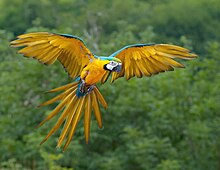There has been a small breeding population in Miami-Dade County, Florida, since the middle 1980s.[2]
They are popular in aviculture because of their striking color, ability to talk, ready availability in the marketplace, and close bonding to humans.


Taxonomy
The Blue-and-Yellow Macaw (Ara ararauna, Linnaeus 1758) is a member of the genus Ara (Lacepede 1799), one of six genera of Central and South American macaws. Protonym: Psittacus ararauna. The species name is derived from Tupi Ara onamatopoeia macao: macaw; Tupi arara: parrot +una: dark or black, hence "dark parrot/macaw".Description
These birds can reach 76 to 86 cm (30 to 34 in) long and weigh 900 to 1500 grams (1.9 to 3.3 lbs), making it one of the larger members of its family. They are vivid in appearance with blue wings and tail, dark blue chin, golden under parts, and a green forehead. Beaks are black. The naked face is white, turning pink in excited birds, and lined with small black feathers.There is little variation in plumage across the range. Some birds have a more orangey or "butterscotch" underside color, particularly on the breast. This was often seen in Trinidad birds and others of the Caribbean area. The Blue-and-yellow Macaw uses its powerful beak for breaking nutshells, and also for climbing up and hanging from trees.
Behavior
Macaws in the wild can be very aggressive, but as babies they can be very playful.Feeding
Macaws primarily eat nuts, seeds and fruits. Occasionally they consume clay at riverbeds, in order to filter out toxins obtained from any unripe nuts they have consumed.Breeding
The Blue-and-yellow Macaw generally mates for life. They nest almost exclusively in dead palms and most nests are in Mauritia flexuosa palms. The female typically lays two or three eggs. The female incubates the eggs for about 28 days. One chick is dominant and gets most of the food; the others perish in the nest. Chicks fledge from the nest about 97 days after hatching. The male bird's color signals readiness for breeding. The brighter and bolder the colors the better the chance of getting a mate is.[3]Distribution and habitat
This species occurs in Venezuela and south to Peru, Brazil, Bolivia, and Paraguay. The range extends slightly into Central America, where it is restricted to Panama. The species' range formerly included Trinidad, but it became extinct there by 1970 as a result of human activities. Between 1999 and 2003, wild caught Blue-and-gold Macaws were translocated from Guyana to Trinidad, in an attempt to reestablish the species in a protected area around Nariva swamp.Conservation and threats
The Blue-and-yellow Macaw is on the verge of being extirpated in Paraguay, but it still remains widespread and fairly common in a large part of mainland South America. The species is therefore listed as Least Concern by BirdLife International. It is listed on CITES Appendix II, trade restricted.Aviculture

Even the most well-tended Blue-and-yellow Macaw will "scream" and make other loud noises. Loud vocalizations, especially "flock calls", and destructive chewing are natural parts of their behavior and should be expected in captivity. Due to their large size, they also require plentiful space in which to fly around. According to World Parrot Trust, an enclosure for a Blue-and-yellow Macaw should, if possible, be at least 50 feet (15 metres) in length.[4]
Given their intelligence, Blue-and-yellow macaws can be taught to do tricks once they have gained enough trust from their owners.
They require a varied diet; a seed only diet will lead to health problems such as vitamin deficiency. An example of a good diet would be a quality pelleted mix, in conjunction with a mix featuring seed, nuts, and dried fruits, with fresh vegetables (greens and roots) and fruits fed regularly; furthermore, it is quite common (and appreciated by the parrot) to partake with their human owners of safe foods like pasta, bread, etc. It is important to avoid foods with high fat content (generally) while striving to provide a wide variety of foods. There are some foods which are toxic to birds and parrots as a group. Cherries and most other Rosaceae pits and seeds, avocados, chocolate, and caffeine are among the foods toxic to parrots. Chocolate and caffeine are not metabolized by birds the same way they are in humans. Rosaceae seeds contain cyanogenic glycosides, and avocados contain persin which are both toxic compounds to birds. Safe foods include oranges, apples, grapes, peanuts, walnuts, and sunflower seeds.
Gallery
-
-
Ara ararauna in Antioquia
See also
References
- BirdLife International (2012). "Ara ararauna". IUCN Red List of Threatened Species. Version 2013.2. International Union for Conservation of Nature. Retrieved 26 November 2013.
- Krishnan, Karunya. "Macaws on campus 'awesome' but noisy." The Miami Hurricane. 2009.
- Alderton, David (2003). The Ultimate Encyclopedia of Caged and Aviary Birds. London, England: Hermes House. p. 235. ISBN 1-84309-164-X.
- "Blue and Gold Macaw (Ara ararauna) | Parrot Care". World Parrot Trust. Retrieved 28 January 2010.
Further reading
- Doane, Bonnie Munro & Qualkinbush, Thomas (1994): My parrot, my friend : an owner's guide to parrot behavior. Howell Book House, New York. ISBN 0-87605-970-1
- ffrench, Richard; O'Neill, John Patton & Eckelberry, Don R. (1991): A guide to the birds of Trinidad and Tobago (2nd edition). Comstock Publishing, Ithaca, N.Y.. ISBN 0-8014-9792-2
- Hilty, Steven L. (2003): Birds of Venezuela. Christopher Helm, London. ISBN 0-7136-6418-5
- Forshaw, J.M. Parrots of the World. New Jersey. T.F.H. Publications Inc. 1978.







No comments:
Post a Comment
Note: Only a member of this blog may post a comment.